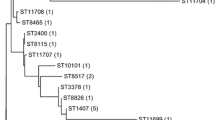Summary
To identify the genomic species of Neisseria gonorrhoeae, evaluate the difference between two molecular epidemiological methods and examine the relationship between sex partners and genotypes of bacteria, 24 strains of Neisseria gonorrhoeae isolated from the outpatients with gonorrhea were identified by using the Opa genotyping and NG-MAST genotyping and the relationship between genotypes and phenotypes was studied. Twenty-four strains of Neisseria gonorrhoeae fell into 10 ST genotypes by NG-MAST genotyping, whereas these strains were classified into 12 OT Opa genotypes by Opa genotyping. A new epidemic strain of ST genotype (217–86% homologisation 178) in China was identified. It is concluded that genotypes of each pair of strains from a pair of patient/ sex partner besides 45/46 are the same, indicating that contagious infection take place between patient and the sex partner. Opa genotyping was more effective than NG-MAST genotyping in identifying the genomic species of Neisseria gonorrhoeae. ST genotype could be further classified into different Opa-types.
Similar content being viewed by others
References
Chen H X, Tu Y T, Lin N X et al. Construction of prokaryotic expression plasmid of mtrC protein of Neisseria gonorrhoeae and its expression in E. coli. J Huazhong Univ Science and Technol [Med Sci], 2005,25(5):582–584
Kline K A, Sechman E V, Skaar E P et al. Recombination, repair and replication in the pathogenic Neisseriae: the 3 R’s of molecular genetics of two human-specific bacterial pathogens. Mol Microbiol, 2003,50(1):3–13
Hobbs M M, Alcorn T M, Davis R H et al. Molecular typing of Neisseria gonorrhoeae causing repeated infections: evolution of porin during passage within a community. J Infect Dis, 1999,179(2):371–381
Sandstrom E, Bygdeman S. Serological classification of Neisseria gonorrhoeae. Clinical and epidemiological applications. Antonie van Leeuwenhoek, 1987,53(6): 375–380
Miles K, Churchward C P, McAuliffe L et al. Identification and differentiation of European and African/Australian strains of Mycoplasma mycoides subspecies mycoides small-colony type using polymerase chain reaction analysis. J Vet Diagn Invest, 2006,18(2):168–171
Bingen E, Barc M C, Brahimi N et al. Randomly amplified polymorphic DNA analysis provides rapid differentiation of methicillin-resistant coagulase-negative staphylococcus bacteremia isolates in pediatric hospital. J Clin Microbiol, 1995,33(6):1657–1659
Young H, McElhinney J, Palmer H M et al. The Scottish gonococcal surveillance contributors: Extended surveillance of gonorrhoea in Scotland 2003. Int J STD AIDS, 2006,17(10):687–692
Martin I M, Ison C A, Aanensen D M et al. Rapid sequence-based identification of gonococcal transmission clusters in a large metropolitan area. J Infect Dis, 2004,189(8):1497–1505
Kostiukova N N, Bekhalo V A. Molecular biological basis of the gonococcal pathogenicity and specific features of immune response. Zh Mikrobiol Epidemiol Immunobiol, 2006,1(1):105–112
O’Rourke M, Ison C A, Renton A M et al. Opa-typing: a high-resolution tool for studying the epidemiology of gonorrhoea. Mol Microbiol, 1995,17(5):865–875
Martin I M, Ghani A, Bell G et al. Persistence of two genotypes of Neisseria gonorrhoeae during transmission. J Clin Microbiol, 2003,41(12):5609–5614
Aydin D, Koksalan K, Komec S et al. Auxo-, sero-, and opa-typing of Neisseria gonorrhoeae strains isolated in Istanbul, Turkey. Sex Transm Dis, 2004,31(10):628–630
Kolader M E, Dukers N H, van der Bij A K et al. Molecular epidemiology of Neisseria gonorrhoeae in Amsterdam, The Netherlands, shows distinct heterosexual and homosexual networks. J Clin Microbiol, 2006,44(8):2689–2697
Spratt B G et al. Multilocus sequence typing: molecular typing of bacterial pathogens in an era of rapid DNA sequencing and the internet. Curr Opin Microbiol, 1999,2(3): 312–316
Viscidi R P, Demma J C, Gu J et al. Comparison of sequencing of the por gene and typing of the opa gene for discrimination of Neisseria gonorrhoeae strains from sexual contacts. J Clin Microbiol, 2000,38(12):4430–4438
Unemo M, Palmer H M, Blackmore T et al. Global transmission of prolyliminopeptidase-negative Neisseria gonorrhoeae strains: implications for changes in diagnostic strategies. Sex Transm Infect, 2007,3(1):7–51
De Jongh M, Dangor Y, Ison C A et al. Neisseria gonorrhoeae multi-antigen sequence typing (NG-MAST) of ciprofloxacin resistant isolates of Pretoria, South Africa. J Clin Pathol, 2008,61(5):686–687
Unemo M, Palmer H M, Blackmore T et al. Global transmission of prolyliminopeptidase-negative Neisseria gonorrhoeae strains: implications for changes in diagnostic strategies. Sex Transm Infect, 2007,83(1):47–51
Martin I M, Ison C A, Aanensen D M et al. Changing epidemiologic profile of quinolone-resistant Neisseria gonorrhoeae in London. J Infect Dis, 2005,192(7):1191–1195
Morris A K, Palmer H M, Young H et al. Opa-typing can identify epidemiologically distinct subgroups within Neisseria gonorrhoeae multi-antigen sequence type (NG-MAST) clusters. Epidemiol Infect, 2008,136(3): 417–420
Author information
Authors and Affiliations
Additional information
Hongxiang CHEN, male, born in 1976, Doctor in Charge
Dr. Hongxiang CHEN and Dr. Zhihong WU contributed equally to the project.
This project was supported by grants from Fund for the National Natural Science Foundation of China (No. 30700717 and No. 30371293) and New Teacher Foundation of Ministry of Education of China (No. 20070487140).
Rights and permissions
About this article
Cite this article
Chen, H., Wu, Z., Chen, R. et al. Typing of Neisseria gonorrhoeae Opa and NG-MAST gene of 12 pairs of sexual contact gonorrhea patients in China. J. Huazhong Univ. Sci. Technol. [Med. Sci.] 28, 472–475 (2008). https://doi.org/10.1007/s11596-008-0422-0
Received:
Published:
Issue Date:
DOI: https://doi.org/10.1007/s11596-008-0422-0




